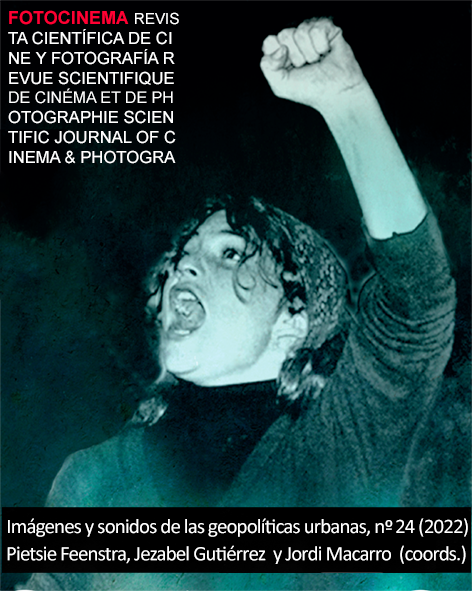Urban representation in the film Blue Jasmine (Woody Allen, 2013).
Analysis of the cinematographic narrative space.
DOI:
https://doi.org/10.24310/Fotocinema.2022.vi24.13521Keywords:
Woody Allen, Blue Jasmine, city, urban tale, filmic analysis, cinematographic narrative spaceAbstract
The city is the object of study of different disciplines, one of those is the cinematographic narrative. Through cinema we can visit cities and discover their identities due to the social representations that the cinematographic narrative disseminates. In addition, the cinema is an eminently spatial art that lends itself to the narrative analysis of the elements that compose it. In this way, with the aim of making known how cities are narrated by the cinematographic discourse, a methodology of filmic analysis in triad has been designed to study the film from three perspectives: iconic, oral and actantial. This methodology has been applied to the film Blue Jasmine (2013), directed by Woody Allen, because represents two cities: New York and San Francisco. The results of the analysis shows the urban tale of each one and the narrative strategies used by the director to film cities.
Downloads
Metrics
Publication Facts
Reviewer profiles N/A
Author statements
Indexed in
-
—
- Academic society
- N/A
- Publisher
- Universidad de Málaga
References
Antoniazzi, S. (2019). La ciudad filmada: cine, espacio e historia urbana. Biblio3W Revista Bibliográfica de Geografía y Ciencias Sociales, XXIV (160), 1-29. DOI: https://doi.org/10.1344/b3w.0.2019.27278
Aumont, J., & Marie, M. (1990). Análisis del film. Barcelona: Ediciones Paidós Ibérica.
Chatman, S. (2013). Historia y discurso: la estructura narrativa en la novela y en el cine. Barcelona: RBA.
De Miguel-Zamora, M. (2016). La trilogía urbana de Woody Allen. Cómo conocer Nueva York a través del cine. Bifurcaciones, (21). Recuperado el 3 de agosto de 2021 de https://bit.ly/3jv02Qq
De Miguel-Zamora, M. (2020). Space system: la ciudad como reclamo publicitario en la obra de Woody Allen. En M. Cháves (Editor), Visiones Urbanas (págs. 519-526). Madrid: Grupo de Investigación Arte, Arquitectura y Comunicación en la Ciudad Contemporánea, Universidad Complutense de Madrid.
Fernández Díez, F., & Martínez Abadía, J. (2003). Manual básico de lenguaje y narrativa audiovisual. Barcelona: Paidós Ibérica.
García Jiménez, J. (1993). Narrativa audiovisual. Madrid: Cátedra.
Giménez, G. (2010). Memoria, relatos e identidades urbanas. Versión: estudios de comunicación y política (23), 197-209. Recuperado el 15 de julio de 2021 de https://bit.ly/3gDMBvG
Gómez-Tarín, F. J., & Marzal Felici, J. (2007). Una propuesta metodológica para el análisis del texto fílmico. Metodologías de análisis del film. Madrid: Actas del I Congreso Internacional sobre Análisis Fílmico. Edipo. Recuperado el 3 de marzo de 2021 de https://bit.ly/3kB1Dng
Llorca, J. (2018). El cine como documento de investigación y evidencia de la modernidad urbana. Estado de la cuestión y una propuesta. Dearq (24), 182-190. DOI: https://doi.org/10.18389/dearq24.2019.10
López Hernández, Á. (2003). El análisis cronológico-secuencial del documento fílmico. Documentación de las Ciencias de la Información (25), 261-294. Recuperado el 5 de abril de 2021 de https://bit.ly/3t0J6V3
Sulbarán Piñeiro, E. (2000). El análisis del film: entre la semiótica del relato y la narrativa fílmica. Opción: Revista de Ciencias Humanas y Sociales (31), 44-71. Recuperado el 5 de abril de 2021 de https://bit.ly/3gJ9i1q
Tovar-Vicente, M. (2014). Midnight in Paris (Woody Allen, 2011): la omisión del pasado como constituyente de la identidad urbana presente. Arte y Ciudad - Revista de Investigación, 7-40.
Tovar-Vicente, M. (2020). La ciudad (re)creada, la urbe filmada: la narración de la metrópolis en “A Roma con amor” (Woody Allen, 2012). En M. A. Cháves (Editor), Visiones urbanas (págs. 575-584). Madrid: Grupo de Investigación Arte, Arquitectura y Comunicación en la Ciudad Contemporánea, Universidad Complutense de Madrid.
Vanoye, F., & Goliot-Lété, A. (2008). Principios del análisis cinematográfico. Madrid: Adaba Editores.
Villafañe, J., & Mínguez, N. (2006). Principios de teoría general de la imagen. Madrid: Ediciones Pirámide.
Downloads
Published
How to Cite
Issue
Section
License
All contents published in Fotocinema Revista científica de cine y fotografía are protected under the Creative Commons Attribution-NonCommercial-ShareAlike 4.0 International (CC BY-NC-SA 4.0) license. All about this license is available in the following link: <http://creativecommons.org/licenses/by-nc-sa/4.0>
Users can copy, use, redistribute, share and exhibit publicly as long as:
- The original source and authorship of the material are cited (Journal, Publisher and URL of the work).
- It is not used for comercial purposes.
- The existence of the license and its especifications are mentioned.
There are two sets of authors’ rights: moral and property rights. Moral rights are perpetual prerogatives, unrenounceable, not-transferable, unalienable, imprescriptible and inembargable. According to authors’ rights legislation, Fotocinema. Revista científica de cine y fotografía recognizes and respects authors moral rights, as well as the ownership of property rights, which will be transferred to University of Malaga in open access. The property rights are referred to the benefits that are gained by the use or the dissemination of works. Fotocinema. Revista científica de cine y fotografía is published in an open access form and it is exclusively licenced by any means for doing or authorising distribution, dissemination, reproduction, , adaptation, translation or arrangement of works.
Authors are responsable for obtaining the necessary permission to use copyrighted images.














13.png)



